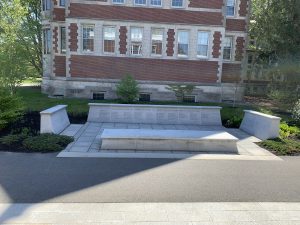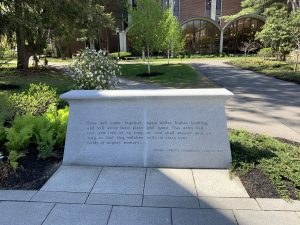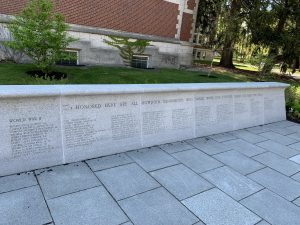The Bowdoin Memorial

The Bowdoin Memorial
The Bowdoin Memorial is a war memorial dedicated to Bowdoin alumni who fought and died in World War II, the Korean War, the Vietnam War, and, although not originally (because the monument predates it), post-9/11 conflicts. The memorial not only lists the names of those who served and died, but also includes quotes from Joshua Chamberlain and Henry Wadsworth Longfellow as inscriptions. The choice of these two men to quote, the contents of their quotes, and the process of finding the names to include on the monument, gives us an idea of the intention of the monument beyond honoring the alumni who lost their lives fighting for their country. The monument attempts to tie the Bowdoin community as an important member and contributor to the United States beyond the sacrifice of the soldiers listed, and to bring the Bowdoin Community together with this understanding.

Quote from Longfellow
Henry Wadsworth Longfellow is not only considered one of the greatest American poets, he is also inseparable from Bowdoin. From Longfellow Avenue to the Hawthorne-Longfellow library, his name is showered all over the campus. Thus, to include his name as part of the permanent inscription of the monument ties the sacrifice of the alumni listed to the intersection of greatness achieved by the Bowdoin community and within the values supported by the United States. Longfellow’s quote reads, “I hear even now the infinite fierce chorus. The cries of agony, the endless groan. Which through the ages that have gone before us, with long reverberations reach our own.” Although written over a century before the monument, the implementation of this quote seeks to highlight both the severity of their efforts (infinite fierce chorus) and sacrifices (cries of agony, endless groan), as well as the benefits of their fighting (long reverberations reach our own). In this context, this quote states that these alumni inscribed here have suffered greatly, but as a result of their fighting for the values of Bowdoin and the US, we are still able to live up to those values and strive for greatness, like that of Longfellow, today.

Quote from Chamberlain
Similarly, the inclusion of a quote from Joshua Chamberlain seeks to draw a link between the Bowdoin community and American heroism. Chamberlain was a Bowdoin alumni and professor who went on to serve as a general for the Union during the Civil War, where he was awarded a Medal of Honor for his success in the Battle of Gettysburg. After the war, he served as Governor of Maine for 4 years, and also served as president of Bowdoin College for 12 years. Joshua Chamberlain played an integral role in both American and Bowdoin History, being of great service and success in both. The inclusion of Chamberlain in the the Bowdoin Memorial can then be seen as an example of what the alumni listed were themselves: heroes to the US and to Bowdoin. Chamberlain’s Quote reads, “They will come together again under higher bidding and will know their place and name. This army will live, and love on so long as soul shall answer soul, so long as that flag watches with its stars over fields of mighty memory…”. In this quote, Chamberlain makes the claim that, as long as America upholds its values, there will be those willing to come forward to defend it when necessary. Including this quote as an inscription on the monument serves to use the sacrifice of the alumni as proof that the quote is is true, that these Bowdoin men were willing to give their lives to uphold American values.
Another important part of the inscription to look into when determining the intention of the monument is the choice of the alumni names listed. More specifically, the choice to not include certain names. First, the plan was to include all alumni who died fighting in these conflicts. Soon, though, this was changed to only include American and Allied soldiers to avoid any controversy. This then led to the question of whether or not to include two particular alumni. The first was Gunther Wilmsen ’30 from Germany. It was first assumed that he was in the Nazi forces and would therefore not be included, however, it was soon clear that he was never a member of their forces. Instead, further research showed that he died while reporting on the war in the western front, most likely providing Nazi propaganda in Germany. As a result, It was clear enough that he did not die in sacrifice for Bowdoin values. The second in question was Manfredi Azzarita from Italy. Similarly, it was first assumed that Azzariti was fighting with the fascists against the allies. However, further research showed that he was actually involved in anti-fascist and anti-nazi movements, executed in a cave alongside 325 others in 1944. With this information, many on the committee were ready to give Azzarita a place on the monument. However, they ultimately decided that they would honor him separately and not as part of the Bowdoin Memorial because, although he was on the same side against fascism, he was not specifically fighting alongside the US or other allied forces. This exclusion continues to highlight the intention of the monument to not only tie Bowdoin to a set of values, but to also tie Bowdoin to the United States, and that those Bowdoin values are American values.
Ultimately, this monument attempts to both honor the sacrifices and contributions of the alumni of the past and to encourage the current Bowdoin community to uphold the American ideals for which they had fought and died for and are intrinsically tied to the Ideals of Bowdoin College.

List of Alumni being remembered
